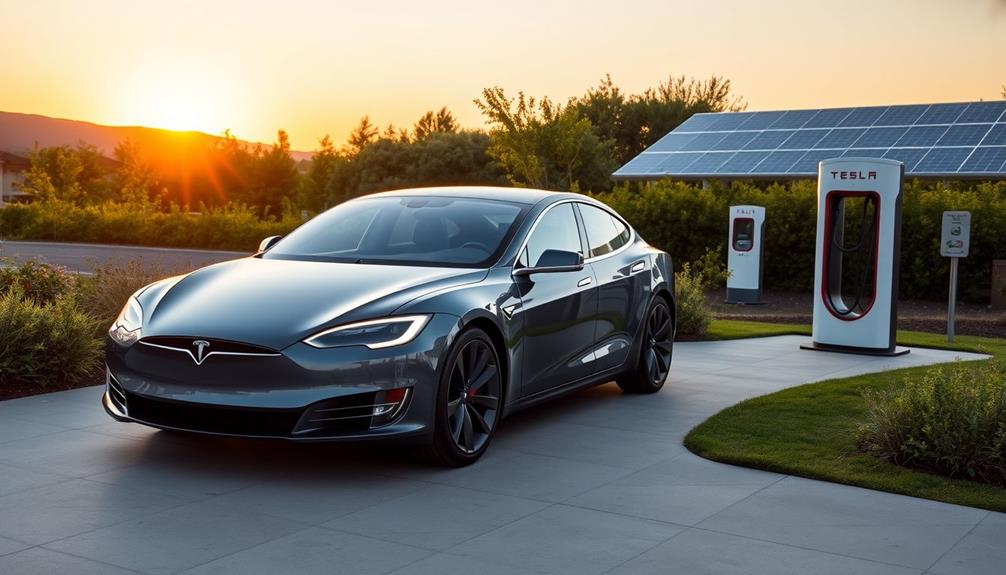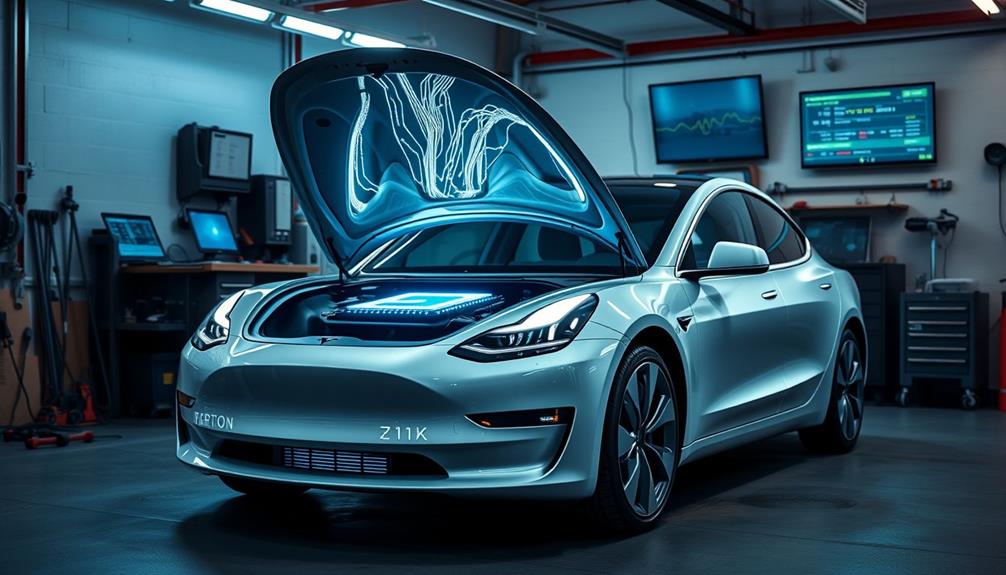Owning a Tesla can definitely be worth it if you're into high performance and sustainability. Models like the Tesla Model 3 are not only cost-effective with low fuel expenses but also offer a fantastic driving experience. Maintenance costs are generally lower than traditional vehicles, and there are potential tax credits to ease the initial investment. However, resale values can drop considerably, so it's important to take into account that. If you're curious about what other factors might influence your decision, you'll find more insights to help you decide.
Key Takeaways
- Tesla vehicles offer significant fuel savings, averaging $614 annually compared to $3,000 for traditional gas vehicles.
- Maintenance costs for Teslas are lower, averaging around $1,490 over five years due to fewer required services.
- Resale values can depreciate significantly, with Model 3 dropping from over $74,000 to around $26,000 in four years.
- The driving experience is exceptional, with models like the Model S Plaid achieving 0-60 mph in just 1.99 seconds.
- Tesla's advanced technology, including Autopilot, enhances safety and convenience but may come with higher insurance costs.
Tesla Overview and Market Position
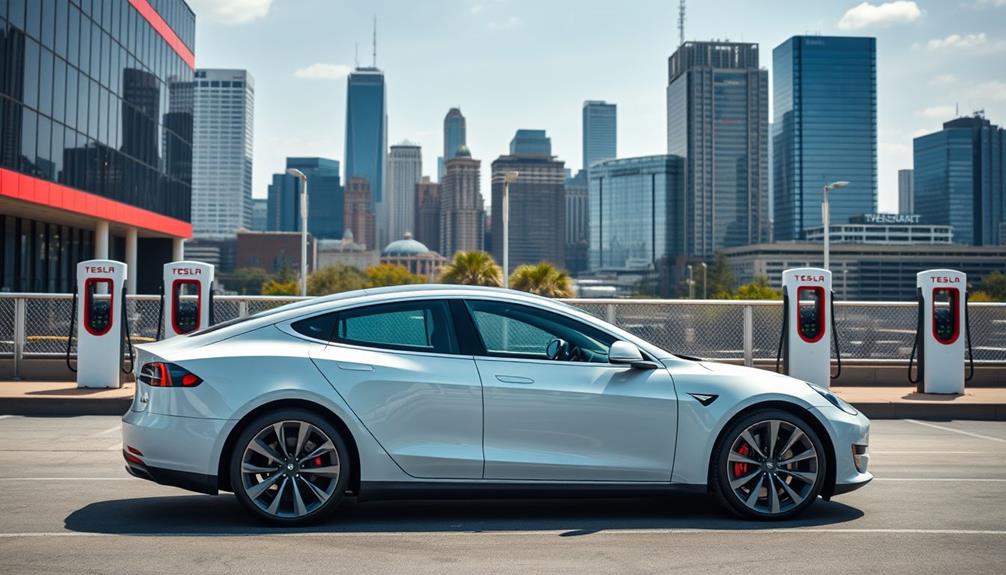
Tesla, founded in 2003, has rapidly emerged as a dominant force in the automotive industry, boasting a market cap of around $785.68 billion as of October 2021. The company's innovative approach to electric vehicles hasn't only set it apart but has also captivated the environmentally conscious consumer.
With a lineup that includes the luxury electric car Model S, alongside the more affordable Model 3, Tesla appeals to a broad audience while maintaining a strong foothold in the luxury segment.
As of 2020, Tesla produced nearly 455,000 vehicles, with the Model 3 and Model Y leading in popularity. This success has helped Tesla carve out a significant market share, rising from 1% to 7.9% in just four years. Such growth reflects an increasing trend toward electric vehicles, showcasing Tesla's commitment to sustainability and innovation.
In the competitive landscape, Tesla often finds itself compared to luxury brands like BMW and Mercedes-Benz, affirming its status among premium car manufacturers.
If you're considering a Tesla, you'll be joining a movement that prioritizes performance, luxury, and environmental responsibility.
Cost of Tesla Models
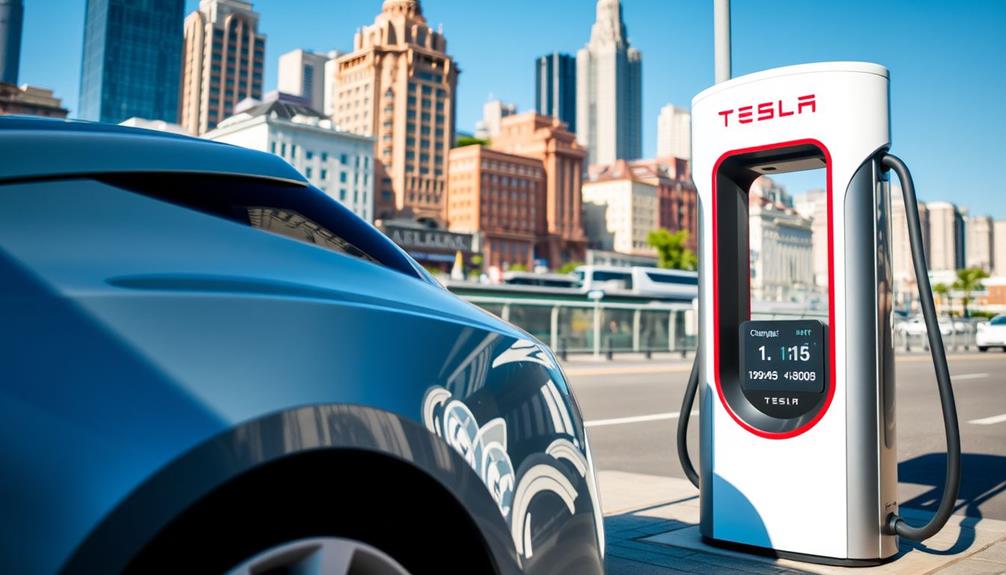
When considering a Tesla, understanding the cost of the various models is key to making an informed decision. The 2021 Tesla Model 3 starts at approximately $39,990, while the Tesla Model Y begins at around $52,990.
If you're looking for luxury, the Model S is priced at $104,990 and the Model X at $120,990. Keep in mind that higher trims and options can greatly increase these prices.
For financing the Model 3, you might face a down payment of about $9,500, leading to monthly payments of around $1,365 over six years at an APR of 2.49%. The total cost of ownership for the Model 3 is estimated at approximately $42,985.25, factoring in financing costs but excluding local taxes and fees.
If you want to enhance your driving experience, consider the additional $10,000 for Full Self-Driving technology. This investment can further raise your overall costs but may offer a unique ownership experience that sets Tesla apart from other vehicles.
Ultimately, knowing these costs will help you determine if owning a Tesla aligns with your budget and expectations.
Financing Options Available

How can you finance your new Tesla? Tesla offers direct financing options, making it easier for you to own an electric vehicle. With an APR starting at 2.49% for a 72-month loan, you can find a plan that suits your budget.
For instance, if you consider the 2021 Model 3, the total financed amount might be around $39,890 after a down payment of about $10,000. This results in a total cost of approximately $42,985.25 over six years, including interest.
When looking at the Model Y, the average total cost for financing is estimated at $40,830.06, with nearly $2,940.06 in interest accrued throughout the loan term. Your monthly payment will vary based on the down payment and the financing options available in your state.
Keep in mind that these options may differ by model, potentially limiting your choices. Understanding the implications of the down payment and interest rates will help you make informed decisions.
Total Cost of Ownership

When you consider owning a Tesla, it's crucial to evaluate the total cost of ownership, which includes the initial purchase price, maintenance, and long-term fuel savings.
While the upfront cost might be higher, you'll likely save on maintenance and fuel compared to traditional vehicles.
Understanding these factors can help you make a more informed decision about your investment.
Initial Purchase Price
Owning a Tesla often comes with a hefty initial purchase price, but understanding the total cost of ownership can provide a clearer picture. The starting price for the 2021 Tesla Model 3 is about $43,190, while the Model Y begins at around $41,190. These figures represent a significant initial cost compared to many traditional vehicles.
When you factor in a home charging station, which can set you back approximately $1,200, the expenses start piling up. Additionally, Tesla's average annual insurance cost is roughly $2,200, higher than many gas-powered cars.
However, you may save on fuel costs, averaging only $614 per year for electricity, compared to $3,000 for gas vehicles.
But keep in mind, Tesla cars experience significant depreciation. For instance, the resale value of a Model 3 can drop from over $74,000 to around $26,000 within four years.
Consider these points as you evaluate your decision:
- Initial purchase price vs. total cost of ownership
- Investment in a home charging station
- Annual insurance costs
- Fuel cost advantages
Maintenance and Repair Costs
Understanding the total cost of ownership also includes maintenance and repair expenses, which tend to be lower for Teslas compared to traditional vehicles. With fewer moving parts, your maintenance cost for a Tesla can average around $1,490 over five years, markedly less than the $4,981 for a Toyota Camry.
You'll find that Tesla's electric engines require less frequent maintenance since there's no need for oil changes, and they've fewer components that wear out over time.
However, keep in mind that Tesla insurance costs can be higher. The average cost to insure a Model S is about $3,673 annually, compared to $2,200 for a conventional car like the Camry.
Additionally, while battery replacement can be a considerable expense, ranging from $12,000 to $16,000, the battery warranty covers you for eight years or 150,000 miles.
Specialized repairs for Teslas may also lead to increased repair costs, as unique components like electrical systems and aluminum frames can be pricier than conventional car repairs.
Long-term Fuel Savings
Fuel efficiency stands as a compelling advantage for Tesla owners, translating into considerable long-term savings. By switching to a Tesla, you can considerably reduce your annual charging costs compared to traditional gas vehicles.
Here's a breakdown of how these savings stack up:
- Annual charging costs: Approximately $614.51 for a Tesla vs. $3,000 for a gas vehicle.
- Fuel costs: Driving a Tesla Model 3 costs around $555 annually for 15,000 miles, while a gas car like a Toyota Camry can run you about $1,589.
- Maintenance costs: With fewer moving parts, Teslas require less maintenance, further contributing to a lower total cost of ownership.
- Initial investment: Though you might spend about $1,200 on a home charging station, this cost often pays off within a couple of years due to your long-term savings.
Additionally, don't forget to factor in available tax credits that can ease your initial investment.
Fuel Economy and Charging Savings

Tesla vehicles offer impressive savings when it comes to fuel economy and charging costs, making them a smart choice for budget-conscious drivers. With an average annual fuel cost of around $614.51, you can markedly reduce your expenses compared to traditional vehicles, which can average about $3,000 annually for gas.
Additionally, understanding your credit score can help you secure better financing options when purchasing a Tesla, further enhancing your financial savings. Charging your Tesla is also economical, costing approximately $0.13 per kWh. This means a full charge on a Model 3 costs about $8, giving you a range of around 353 miles.
While installing a home charging station might set you back about $1,200, the long-term savings on fuel can quickly offset that initial investment.
When you look at the numbers, a gasoline vehicle like the Toyota Camry, which incurs annual fuel costs of about $1,589, will cost you more in the long run. Tesla's electric driving cost sits at about $0.037 per mile, making it more economical than many internal combustion engine vehicles.
With these fuel economy and charging savings, owning a Tesla can be a financially savvy decision for your everyday driving needs. However, it’s important to consider the hidden costs of Tesla ownership, such as higher insurance premiums and potential expenses for home charging setup. Additionally, while Tesla vehicles tend to have fewer mechanical issues due to their electric nature, out-of-warranty repairs and maintenance can still add up over time. Therefore, weighing these factors alongside the savings is key to making a well-informed decision.
Depreciation and Resale Value

When you own a Tesla, it's important to understand how depreciation impacts your investment.
You'll notice that values can drop considerably within the first few months, influenced by market fluctuations and early adopter dynamics.
However, as the EV market grows, you might find some stabilization in resale values over time.
Initial Depreciation Trends
Many owners notice that the initial depreciation of electric vehicles, especially the Model 3, can be quite steep. This trend can be surprising, particularly when assessing the significant resale value drop from over $74,000 to around $26,000 after nearly four years and 33,000 miles.
Several factors contribute to this initial depreciation:
- Early adopter challenges: Many buyers face fluctuating prices and quality issues, impacting their resale experience.
- Market fluctuations: As the electric vehicle market share grows from 1% to 7.9%, resale values for Teslas can be unpredictable compared to traditional vehicles.
- Manufacturing efficiencies: Increased competition in the EV sector often leads to lower resale values over time.
- Initial depreciation period: Most Tesla models see substantial depreciation within the first six months, making it essential to evaluate your ownership timeline.
Understanding these trends can help you make informed decisions about buying a Tesla.
While the electric vehicle market is expanding, be prepared for the potential financial implications of initial depreciation on your Tesla Model 3.
Resale Value Comparisons
Resale values of electric vehicles, particularly the Model 3, can be surprising when compared to traditional cars. While the Model 3 initially sold for over $74,000, its resale value plummeted to around $26,000 after nearly four years, showcasing significant depreciation, especially within the first six months of ownership.
Despite this, Tesla vehicles generally maintain stronger resale values than many traditional vehicles, thanks to the brand's reputation and the rising demand for electric vehicles.
In comparison, the Tesla Model S experiences an overall depreciation rate of about 36.3% within three years, which is significantly lower than the average depreciation for luxury vehicles.
However, it's crucial to understand that market fluctuations can lead to depreciation rates for Teslas that sometimes exceed those of conventional cars. Early EV adopters often find themselves grappling with fluctuating prices shortly after their purchase.
As the electric vehicle market share increases from 1% to 7.9% over four years, the resale values of Teslas could be influenced by manufacturing efficiencies and evolving market dynamics.
Ultimately, knowing these factors can help you make a more informed decision about purchasing a Tesla.
Market Fluctuations Impact
Although owning a Tesla can offer unique advantages, understanding the impact of market fluctuations on depreciation and resale value is essential for potential buyers. Tesla vehicles tend to experience significant depreciation, with models like the Model 3 dropping from over $74,000 to around $26,000 within four years and 33,000 miles. Early adopters often see dramatic price drops even within six months of purchase.
Here are some key considerations regarding Tesla resale values:
- Electric vehicle market growth: The market share for EVs has surged from 1% to 7.9% recently, influencing all resale values.
- Impact of competition: As more manufacturers enter the electric vehicle market, the competition affects Tesla's resale values.
- Manufacturing efficiencies: Improvements in manufacturing can lead to lower new car prices, impacting resale values.
- Higher retention: While Teslas generally hold their value better than traditional vehicles, depreciation remains a vital factor.
For potential buyers, being aware of these market fluctuations is significant to making an informed decision about investing in a Tesla.
Driving Experience and Performance

When you get behind the wheel of a Tesla, you immediately feel the thrill of its remarkable performance. Tesla vehicles are engineered for an exhilarating driving experience, with the Model S Plaid achieving an astonishing 0-60 mph in just 1.99 seconds. The Model 3 Performance variant also impresses, reaching 60 mph in 3.1 seconds, showcasing exceptional acceleration that rivals many gasoline-powered cars.
The all-wheel drive capabilities enhance traction and stability, allowing you to conquer various road conditions effortlessly. This unique driving experience often leads to what enthusiasts call the "Tesla Grin."
You'll appreciate the extensive range capabilities, with the Model S offering up to 412 miles and the Model 3 up to 358 miles on a single charge. This means fewer stops for recharging, making long-distance travel much more convenient.
Equipped with advanced driver-assistance systems like Autopilot, Tesla vehicles not only provide thrilling performance but also enhance safety and convenience during your drives.
Essentially, owning a Tesla means embracing cutting-edge technology, impressive acceleration, and a dynamic driving experience that sets it apart from the competition.
Customer Service and Support

Owning a Tesla isn't just about the thrilling driving experience; it also involves maneuvering through the customer service and support landscape. Many owners report mixed experiences, especially with warranty claims and repair assistance.
Communication challenges can often lead to frustration, and the responsiveness of Tesla's service department varies widely among users.
Here are some key points to take into account:
- Warranty claims for cosmetic repairs may be limited, often leaving you with out-of-pocket expenses.
- The Tesla Motors Club (TMC) can be a valuable resource, providing a community for support and shared experiences.
- Availability of service appointments can be a pain point, especially in high-demand areas, which may affect your satisfaction.
- Overall quality of customer service remains inconsistent, leading to varying experiences among owners.
Navigating these issues can be tricky, but knowing what to expect can help you manage your Tesla ownership experience better.
While some owners find the support satisfactory, others face challenges that may impact their overall enjoyment of the vehicle.
Alternatives to Tesla Vehicles
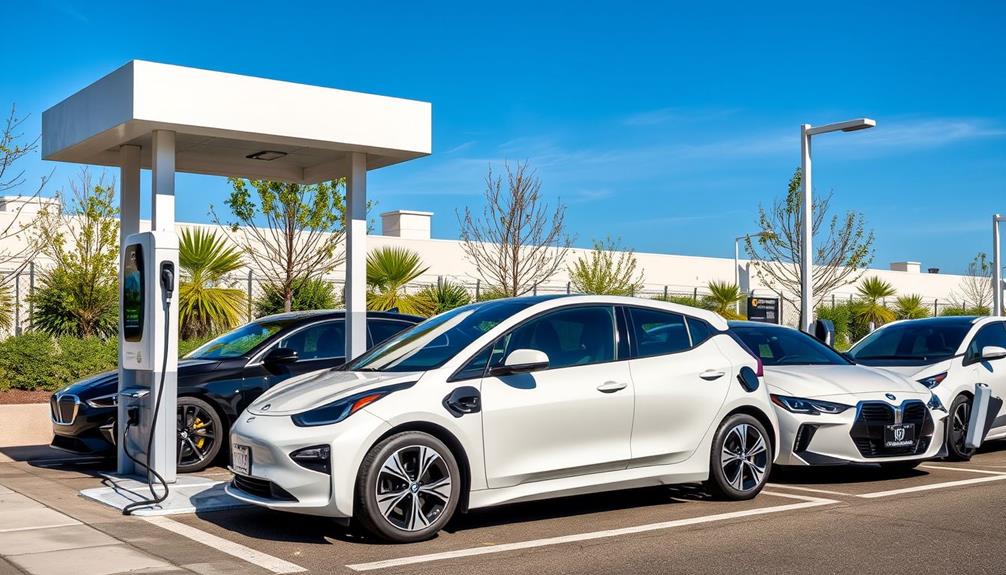
As the electric vehicle market expands, many drivers are exploring alternatives to Tesla vehicles that offer unique features and benefits.
One affordable option is the Nissan Leaf, which starts around $27,000 and provides a range of up to 150 miles—perfect for budget-conscious buyers.
If you're after a stylish electric SUV, the Ford Mustang Mach-E might catch your eye, featuring multiple range options up to 300 miles and a starting price of approximately $43,895.
For those seeking a compact yet spacious option, the Kia Niro EV delivers versatility with a range of about 239 miles, starting near $39,550.
Meanwhile, the Volkswagen ID.4 stands out as a fully-electric SUV, beginning at around $39,995 and offering up to 250 miles of range along with modern tech features, ideal for families needing extra room.
Lastly, if luxury is what you're after, consider the Lucid Air, which offers a premium experience, a range of up to 516 miles, and starts at $77,400.
With these alternatives to Tesla vehicles, you can find an electric option that fits your lifestyle and budget.
Tax Credits and Incentives

When you buy a Tesla, you might qualify for a federal tax credit of up to $7,500, which can make your purchase more affordable.
Additionally, many states offer their own incentives, sometimes adding another $2,500 to your savings.
It's essential to check the eligibility requirements for both federal and state credits to maximize your benefits.
Federal Tax Credit Benefits
Purchasing a Tesla can come with substantial financial perks through federal and state tax credits. Although Tesla buyers may qualify for a federal tax credit of up to $7,500, it's essential to recognize that this credit has phased out for Tesla vehicles since 2020 due to sales thresholds being met.
However, state-specific tax credits can still offer additional savings.
Here are a few key points to keep in mind:
- Eligibility requirements: Federal and state incentives depend on your Tesla model and your tax liability.
- Financial attractiveness: These tax incentives can greatly reduce the overall purchase cost of your Tesla.
- State-specific variations: Some states provide incentives as high as $2,500 based on local regulations.
- Legislative changes: Tax incentives can change, so staying updated on potential impacts is vital.
Understanding these aspects can help you navigate the financial benefits of owning a Tesla while maximizing your savings.
Always research your state's offerings and consult a tax professional to guarantee you make the most of any available tax credits.
State-Specific Incentives Overview
Understanding state-specific incentives is vital for maximizing your savings when owning a Tesla. Many states offer additional tax credits and rebates that can greatly lower your cost of ownership.
For instance, California has the Clean Vehicle Rebate Program, which provides up to $2,000 for qualifying Tesla purchases. If you're in Colorado, you could snag up to $5,000 in tax credits for electric vehicles, making the switch even more appealing.
States like New York also offer various incentives that can enhance your savings. Plus, some states give electric vehicle owners perks like access to HOV lanes and reduced registration fees, further sweetening the deal.
These state-specific incentives vary based on your income level, the price of the vehicle, and whether you're purchasing or leasing.
To truly benefit from these incentives, it's important to research and understand the specific rules in your state. By taking advantage of these financial benefits, you can make owning a Tesla not just an environmentally friendly choice but also a financially savvy one.
Eligibility Requirements Explained
Maneuvering the eligibility requirements for tax credits and incentives can be a bit tricky when it comes to owning a Tesla. As a Tesla buyer, it's important to understand that the federal tax credit of up to $7,500 is no longer available due to the sales cap phase-out.
However, state tax credits can still provide a financial benefit, so you'll want to explore those options thoroughly.
Here are some factors to keep in mind:
- State Tax Credits: These can vary greatly; some states offer up to $2,500.
- Eligibility Criteria: Check if specific Tesla models qualify for state incentives.
- Income Levels: Some states have income-based eligibility criteria that could affect you.
- Purchase Price: The purchase price of your Tesla may influence your eligibility for certain incentives.
It's vital to stay updated on any potential changes in tax incentives or rebates.
Your overall cost of ownership can be greatly affected by these factors, so doing your research will help you maximize the benefits of your Tesla ownership experience.
Frequently Asked Questions
What Is the Downside of Owning a Tesla?
Owning a Tesla has downsides, like high insurance costs and potential battery replacement expenses. Customer service can frustrate you, and charging infrastructure might challenge your long trips, making ownership less convenient than you'd expect.
Is Owning a Tesla Considered Rich?
Owning a Tesla often signals wealth, given its price range and higher insurance costs. When you drive one, you're not just enjoying advanced technology; you're also embracing the prestige that comes with the brand.
Is Owning a Tesla Cheaper Than Gas?
Imagine gliding silently down the road, knowing you're spending less on fuel. Owning a Tesla often means saving considerably on fuel costs compared to gas vehicles, especially if you drive a lot. It's economical.
Are There Any Benefits to Owning a Tesla?
Owning a Tesla offers numerous benefits like significant fuel savings, lower maintenance costs, and access to an extensive Supercharger network. Plus, you'll enjoy advanced technology features and strong resale values that keep your investment solid.
Conclusion
Ultimately, owning a Tesla can feel like driving a high-tech spaceship through a futuristic city. You've got cutting-edge performance, impressive savings on fuel, and a commitment to sustainability. However, it's essential to weigh the costs and benefits against your lifestyle. Just like any investment, it's not just about the shiny exterior; it's about how it fits into your daily life. If it aligns with your values and needs, owning a Tesla could be a stellar choice.
